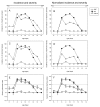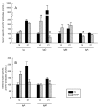Prevention of Rotavirus Diarrhea in Suckling Rats by a Specific Fermented Milk Concentrate with Prebiotic Mixture
- PMID: 30669251
- PMCID: PMC6356616
- DOI: 10.3390/nu11010189
Prevention of Rotavirus Diarrhea in Suckling Rats by a Specific Fermented Milk Concentrate with Prebiotic Mixture
Abstract
Several microbial modulatory concepts, such as certain probiotics and prebiotics, confer protection against gastrointestinal infections, among which is acute diarrhea caused by the rotavirus (RV). Other microbiota modulators, such as postbiotics, produced during fermentation, might also have the potential to counteract RV infection. In light of this, a fermented milk, made by using Bifidobacterium breve C50 (BbC50) and Streptococcus thermophilus 065 (St065) with a prebiotic mixture-short chain galactooligosaccharides/long chain fructooligosaccharides (scGOS/lcFOS 9:1)-with potential to impact the intestinal microbiota composition was tested. An RV infected rat model was used to evaluate the amelioration of the infectious process and the improvement of the immune response induced by the fermented milk with prebiotic mixture. The dietary intervention caused a reduction in the clinical symptoms of diarrhea, such as severity and incidence. Furthermore, a modulation of the immune response was observed, which might enhance the reduction of the associated diarrhea. In addition, the fermented milk with prebiotic mixture was able to bind the virus and reduce its clearance. In conclusion, the postbiotic components in the fermented milk in combination with the prebiotics used here showed protective properties against RV infection.
Keywords: fermented formula; postbiotic; prebiotic; probiotic; rotavirus.
Conflict of interest statement
The authors declare that they have a financial relationship with the organization that sponsored the research. K.v.L., K.K., J.G. and J.K. are employees of Nutricia Research B.V. The other authors declare that they have no conflicts of interest.
Figures





Similar articles
-
A fermented milk concentrate and a combination of short-chain galacto-oligosaccharides/long-chain fructo-oligosaccharides/pectin-derived acidic oligosaccharides protect suckling rats from rotavirus gastroenteritis.Br J Nutr. 2017 Jan;117(2):209-217. doi: 10.1017/S0007114516004566. Epub 2017 Feb 7. Br J Nutr. 2017. PMID: 28166850
-
Fermented infant formula (with Bifidobacterium breve C50 and Streptococcus thermophilus O65) with prebiotic oligosaccharides is safe and modulates the gut microbiota towards a microbiota closer to that of breastfed infants.Clin Nutr. 2021 Mar;40(3):778-787. doi: 10.1016/j.clnu.2020.07.024. Epub 2020 Jul 23. Clin Nutr. 2021. PMID: 32893049 Clinical Trial.
-
A combination of scGOS/lcFOS with Bifidobacterium breve M-16V protects suckling rats from rotavirus gastroenteritis.Eur J Nutr. 2017 Jun;56(4):1657-1670. doi: 10.1007/s00394-016-1213-1. Epub 2016 Apr 25. Eur J Nutr. 2017. PMID: 27112962
-
Probiotics, prebiotics, and synbiotics.Adv Biochem Eng Biotechnol. 2008;111:1-66. doi: 10.1007/10_2008_097. Adv Biochem Eng Biotechnol. 2008. PMID: 18461293 Review.
-
Modulation of rotavirus severe gastroenteritis by the combination of probiotics and prebiotics.Arch Microbiol. 2017 Sep;199(7):953-961. doi: 10.1007/s00203-017-1400-3. Epub 2017 Jun 20. Arch Microbiol. 2017. PMID: 28634691 Free PMC article. Review.
Cited by
-
Analysis of the intestinal microbial community altered during rotavirus infection in suckling mice.Virol J. 2021 Dec 20;18(1):254. doi: 10.1186/s12985-021-01727-5. Virol J. 2021. PMID: 34930341 Free PMC article.
-
The Anti-Rotaviral Activity of Low Molecular Weight and Non-Proteinaceous Substance from Bifidobacterium longum BORI Cell Extract.Microorganisms. 2019 Apr 23;7(4):108. doi: 10.3390/microorganisms7040108. Microorganisms. 2019. PMID: 31018530 Free PMC article.
-
Potential Antitumor Effect of Functional Yogurts Formulated with Prebiotics from Cereals and a Consortium of Probiotic Bacteria.Foods. 2023 Mar 15;12(6):1250. doi: 10.3390/foods12061250. Foods. 2023. PMID: 36981175 Free PMC article.
-
Supplementation with galacto-oligosaccharides in early life persistently facilitates the microbial colonization of the rumen and promotes growth of preweaning Holstein dairy calves.Anim Nutr. 2022 May 11;10:223-233. doi: 10.1016/j.aninu.2022.04.009. eCollection 2022 Sep. Anim Nutr. 2022. PMID: 35785255 Free PMC article.
-
Strain-Specific Probiotic Properties of Bifidobacteria and Lactobacilli for the Prevention of Diarrhea Caused by Rotavirus in a Preclinical Model.Nutrients. 2020 Feb 15;12(2):498. doi: 10.3390/nu12020498. Nutrients. 2020. PMID: 32075234 Free PMC article.
References
-
- Estes M., Greenberg H. Rotaviruses. In: Knipe D.M., Howley P.M., editors. Fields Virology. Lippincott Williams & Wilkins; Philadelphia, PA, USA: 2013.
-
- Hill C., Guarner F., Reid G., Gibson G.R., Merenstein D.J., Pot B., Morelli L., Canani R.B., Flint H.J., Salminen S., et al. Expert consensus document: The International Scientific Association for Probiotics and Prebiotics consensus statement on the scope and appropriate use of the term probiotic. Nat. Rev. Gastroenterol. Hepatol. 2014;11:506–514. doi: 10.1038/nrgastro.2014.66. - DOI - PubMed
MeSH terms
Substances
Grants and funding
LinkOut - more resources
Full Text Sources
Other Literature Sources
Medical

